Strategies to Overcome Employee Resistance to Change in Workplace
VerifiedAdded on 2023/06/03
|6
|1562
|164
Report
AI Summary
This report explores the phenomenon of employee resistance to change within organizations, identifying various reasons for this resistance, such as fear of job loss, lack of trust, poor communication, and discomfort with leaving familiar routines. It emphasizes the importance of change management in ensuring a smoother transition and discusses strategies to mitigate resistance, including effective communication, stakeholder engagement, and phased implementation of changes. The report concludes that by understanding the causes of resistance and implementing appropriate strategies, organizations can improve the success rate of their change initiatives. Desklib provides solved assignments and past papers for students.
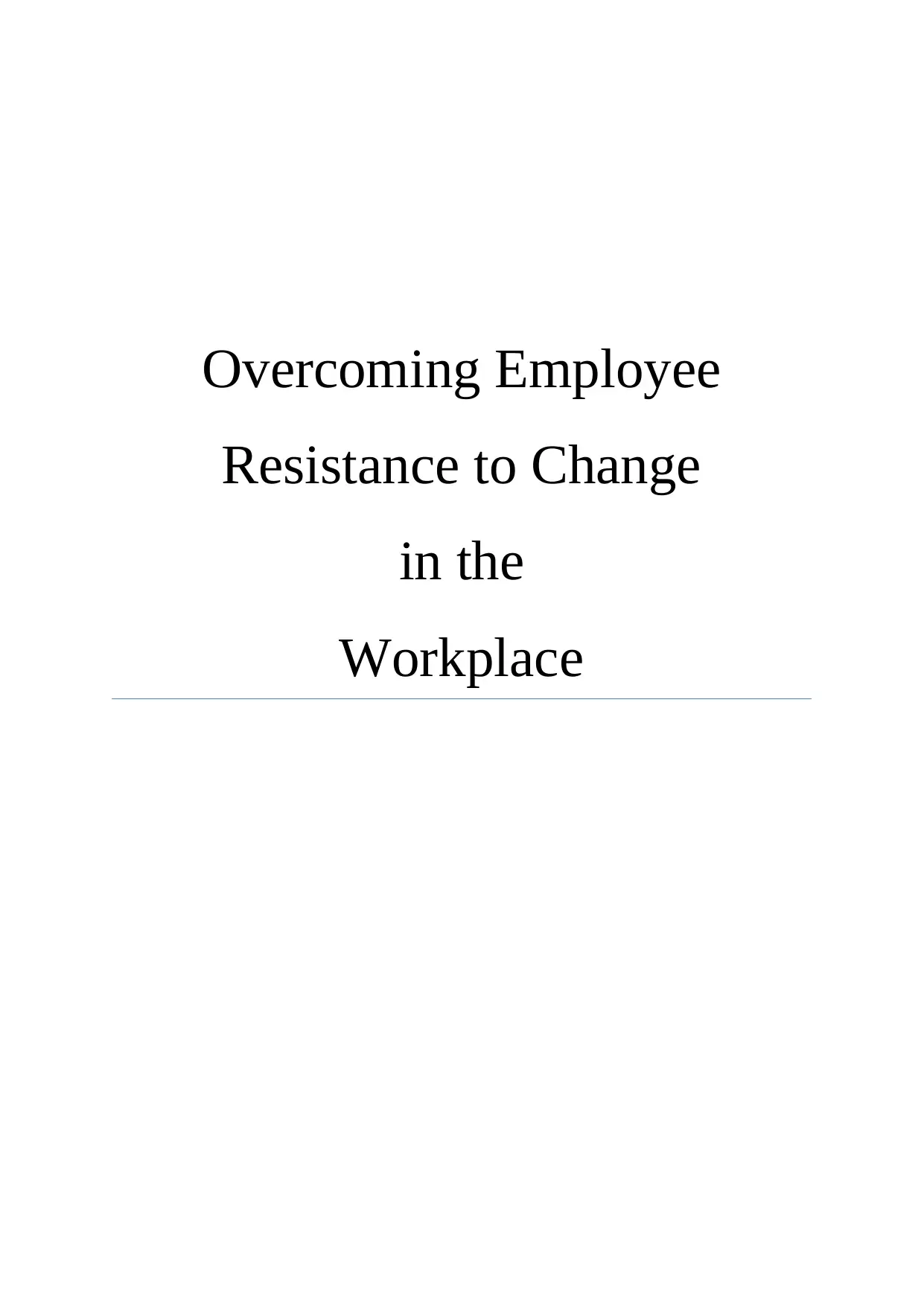
Overcoming Employee
Resistance to Change
in the
Workplace
Resistance to Change
in the
Workplace
Paraphrase This Document
Need a fresh take? Get an instant paraphrase of this document with our AI Paraphraser
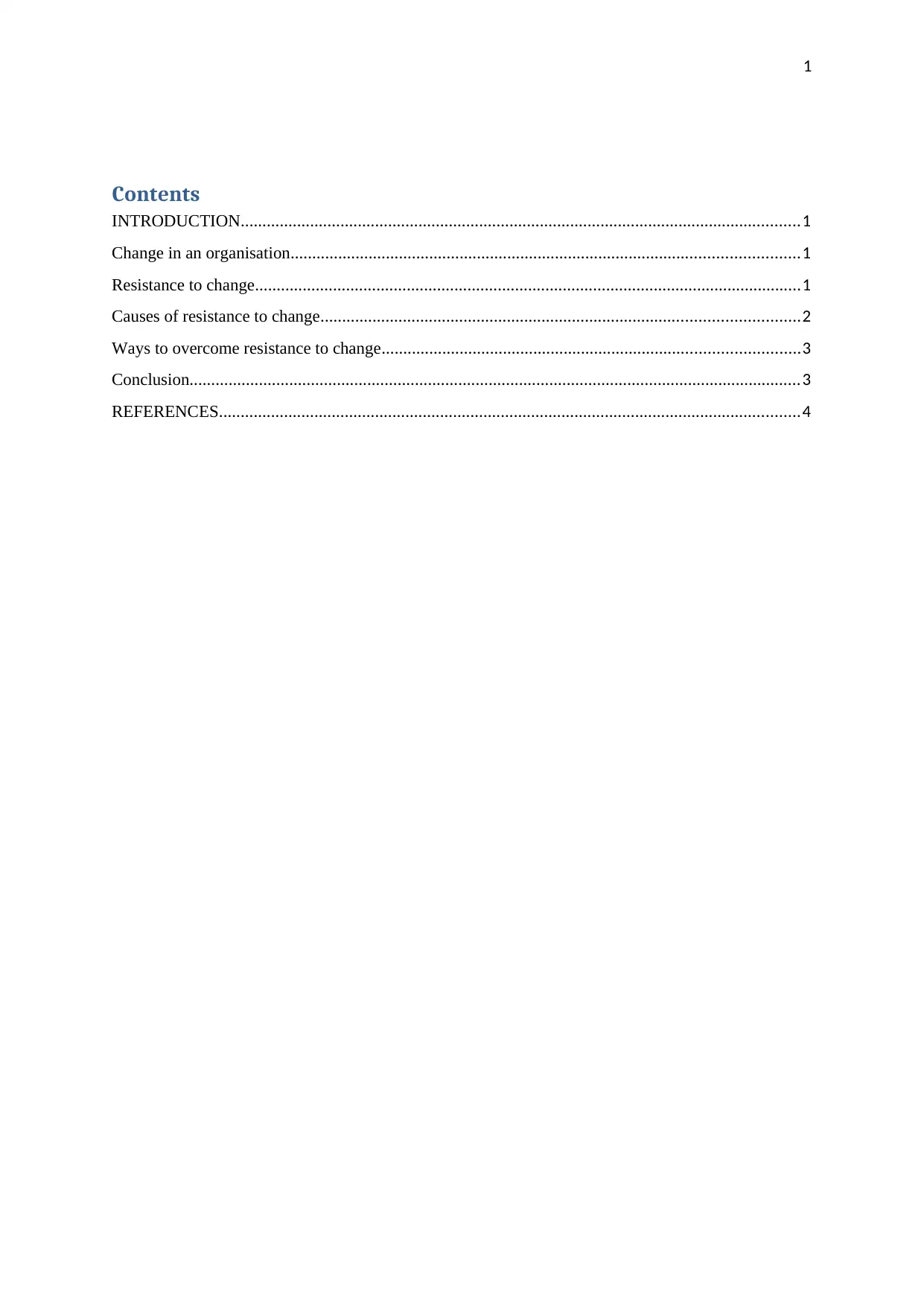
1
Contents
INTRODUCTION.................................................................................................................................1
Change in an organisation.....................................................................................................................1
Resistance to change..............................................................................................................................1
Causes of resistance to change..............................................................................................................2
Ways to overcome resistance to change................................................................................................3
Conclusion.............................................................................................................................................3
REFERENCES......................................................................................................................................4
Contents
INTRODUCTION.................................................................................................................................1
Change in an organisation.....................................................................................................................1
Resistance to change..............................................................................................................................1
Causes of resistance to change..............................................................................................................2
Ways to overcome resistance to change................................................................................................3
Conclusion.............................................................................................................................................3
REFERENCES......................................................................................................................................4
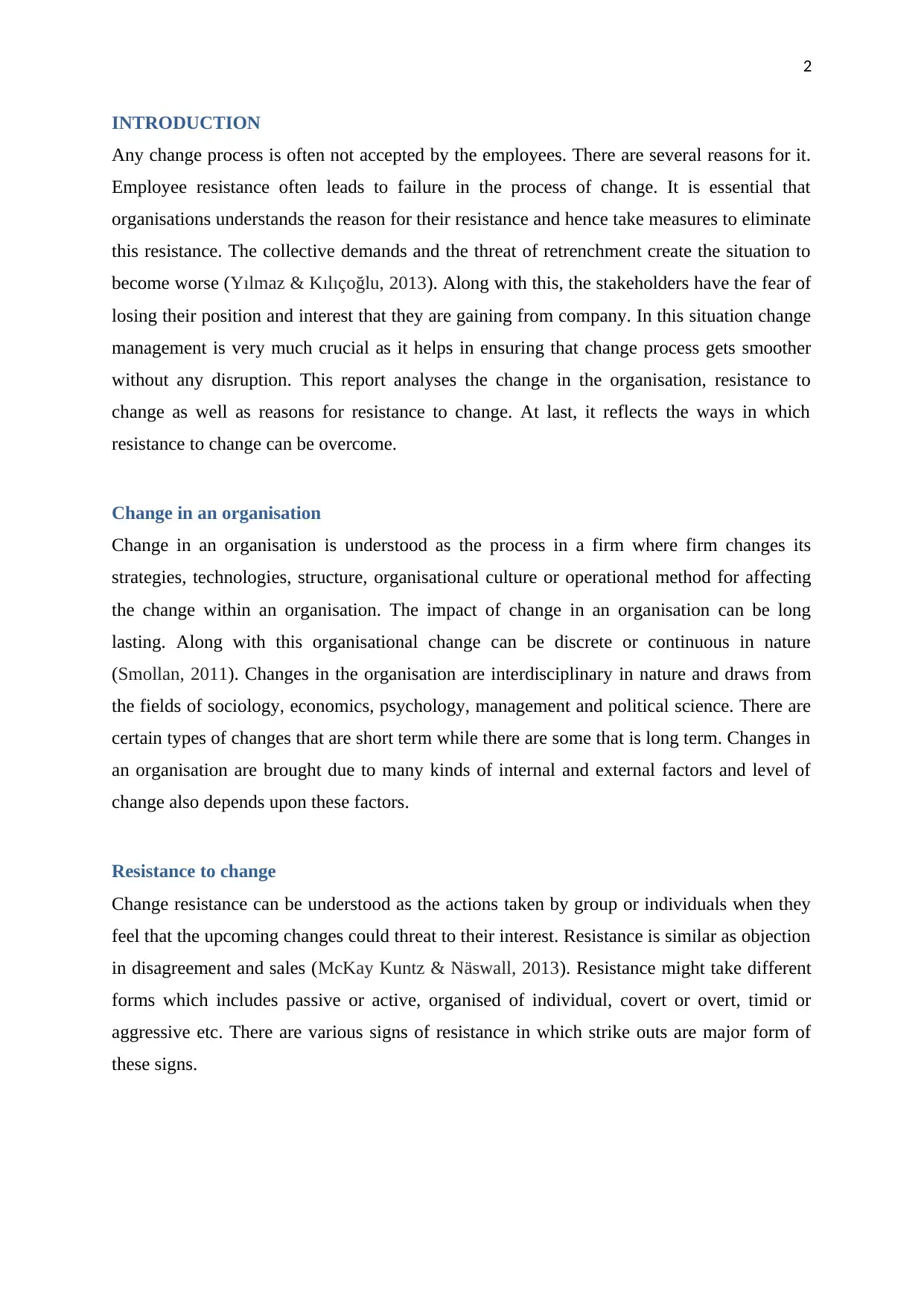
2
INTRODUCTION
Any change process is often not accepted by the employees. There are several reasons for it.
Employee resistance often leads to failure in the process of change. It is essential that
organisations understands the reason for their resistance and hence take measures to eliminate
this resistance. The collective demands and the threat of retrenchment create the situation to
become worse (Yılmaz & Kılıçoğlu, 2013). Along with this, the stakeholders have the fear of
losing their position and interest that they are gaining from company. In this situation change
management is very much crucial as it helps in ensuring that change process gets smoother
without any disruption. This report analyses the change in the organisation, resistance to
change as well as reasons for resistance to change. At last, it reflects the ways in which
resistance to change can be overcome.
Change in an organisation
Change in an organisation is understood as the process in a firm where firm changes its
strategies, technologies, structure, organisational culture or operational method for affecting
the change within an organisation. The impact of change in an organisation can be long
lasting. Along with this organisational change can be discrete or continuous in nature
(Smollan, 2011). Changes in the organisation are interdisciplinary in nature and draws from
the fields of sociology, economics, psychology, management and political science. There are
certain types of changes that are short term while there are some that is long term. Changes in
an organisation are brought due to many kinds of internal and external factors and level of
change also depends upon these factors.
Resistance to change
Change resistance can be understood as the actions taken by group or individuals when they
feel that the upcoming changes could threat to their interest. Resistance is similar as objection
in disagreement and sales (McKay Kuntz & Näswall, 2013). Resistance might take different
forms which includes passive or active, organised of individual, covert or overt, timid or
aggressive etc. There are various signs of resistance in which strike outs are major form of
these signs.
INTRODUCTION
Any change process is often not accepted by the employees. There are several reasons for it.
Employee resistance often leads to failure in the process of change. It is essential that
organisations understands the reason for their resistance and hence take measures to eliminate
this resistance. The collective demands and the threat of retrenchment create the situation to
become worse (Yılmaz & Kılıçoğlu, 2013). Along with this, the stakeholders have the fear of
losing their position and interest that they are gaining from company. In this situation change
management is very much crucial as it helps in ensuring that change process gets smoother
without any disruption. This report analyses the change in the organisation, resistance to
change as well as reasons for resistance to change. At last, it reflects the ways in which
resistance to change can be overcome.
Change in an organisation
Change in an organisation is understood as the process in a firm where firm changes its
strategies, technologies, structure, organisational culture or operational method for affecting
the change within an organisation. The impact of change in an organisation can be long
lasting. Along with this organisational change can be discrete or continuous in nature
(Smollan, 2011). Changes in the organisation are interdisciplinary in nature and draws from
the fields of sociology, economics, psychology, management and political science. There are
certain types of changes that are short term while there are some that is long term. Changes in
an organisation are brought due to many kinds of internal and external factors and level of
change also depends upon these factors.
Resistance to change
Change resistance can be understood as the actions taken by group or individuals when they
feel that the upcoming changes could threat to their interest. Resistance is similar as objection
in disagreement and sales (McKay Kuntz & Näswall, 2013). Resistance might take different
forms which includes passive or active, organised of individual, covert or overt, timid or
aggressive etc. There are various signs of resistance in which strike outs are major form of
these signs.
⊘ This is a preview!⊘
Do you want full access?
Subscribe today to unlock all pages.

Trusted by 1+ million students worldwide
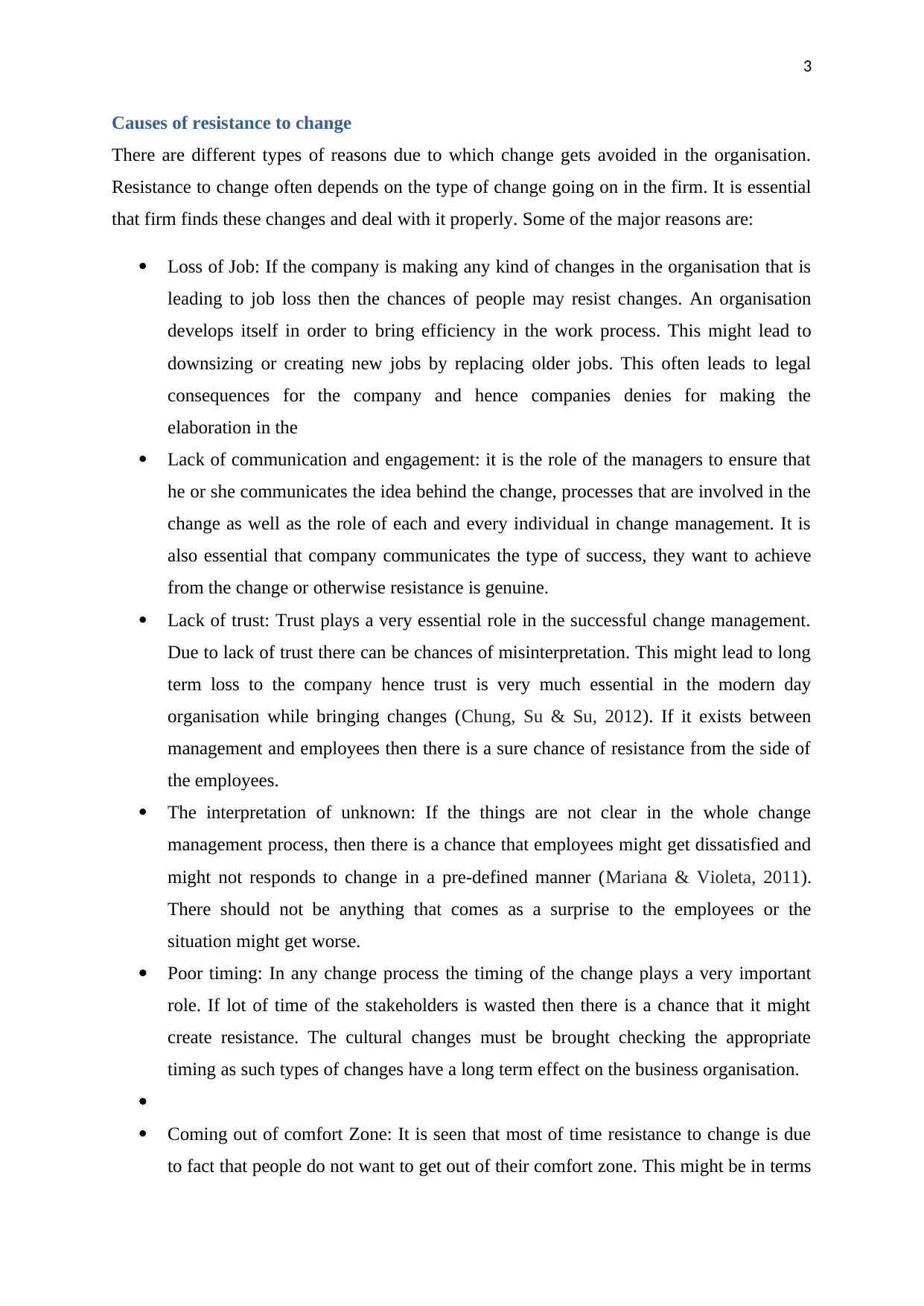
3
Causes of resistance to change
There are different types of reasons due to which change gets avoided in the organisation.
Resistance to change often depends on the type of change going on in the firm. It is essential
that firm finds these changes and deal with it properly. Some of the major reasons are:
Loss of Job: If the company is making any kind of changes in the organisation that is
leading to job loss then the chances of people may resist changes. An organisation
develops itself in order to bring efficiency in the work process. This might lead to
downsizing or creating new jobs by replacing older jobs. This often leads to legal
consequences for the company and hence companies denies for making the
elaboration in the
Lack of communication and engagement: it is the role of the managers to ensure that
he or she communicates the idea behind the change, processes that are involved in the
change as well as the role of each and every individual in change management. It is
also essential that company communicates the type of success, they want to achieve
from the change or otherwise resistance is genuine.
Lack of trust: Trust plays a very essential role in the successful change management.
Due to lack of trust there can be chances of misinterpretation. This might lead to long
term loss to the company hence trust is very much essential in the modern day
organisation while bringing changes (Chung, Su & Su, 2012). If it exists between
management and employees then there is a sure chance of resistance from the side of
the employees.
The interpretation of unknown: If the things are not clear in the whole change
management process, then there is a chance that employees might get dissatisfied and
might not responds to change in a pre-defined manner (Mariana & Violeta, 2011).
There should not be anything that comes as a surprise to the employees or the
situation might get worse.
Poor timing: In any change process the timing of the change plays a very important
role. If lot of time of the stakeholders is wasted then there is a chance that it might
create resistance. The cultural changes must be brought checking the appropriate
timing as such types of changes have a long term effect on the business organisation.
Coming out of comfort Zone: It is seen that most of time resistance to change is due
to fact that people do not want to get out of their comfort zone. This might be in terms
Causes of resistance to change
There are different types of reasons due to which change gets avoided in the organisation.
Resistance to change often depends on the type of change going on in the firm. It is essential
that firm finds these changes and deal with it properly. Some of the major reasons are:
Loss of Job: If the company is making any kind of changes in the organisation that is
leading to job loss then the chances of people may resist changes. An organisation
develops itself in order to bring efficiency in the work process. This might lead to
downsizing or creating new jobs by replacing older jobs. This often leads to legal
consequences for the company and hence companies denies for making the
elaboration in the
Lack of communication and engagement: it is the role of the managers to ensure that
he or she communicates the idea behind the change, processes that are involved in the
change as well as the role of each and every individual in change management. It is
also essential that company communicates the type of success, they want to achieve
from the change or otherwise resistance is genuine.
Lack of trust: Trust plays a very essential role in the successful change management.
Due to lack of trust there can be chances of misinterpretation. This might lead to long
term loss to the company hence trust is very much essential in the modern day
organisation while bringing changes (Chung, Su & Su, 2012). If it exists between
management and employees then there is a sure chance of resistance from the side of
the employees.
The interpretation of unknown: If the things are not clear in the whole change
management process, then there is a chance that employees might get dissatisfied and
might not responds to change in a pre-defined manner (Mariana & Violeta, 2011).
There should not be anything that comes as a surprise to the employees or the
situation might get worse.
Poor timing: In any change process the timing of the change plays a very important
role. If lot of time of the stakeholders is wasted then there is a chance that it might
create resistance. The cultural changes must be brought checking the appropriate
timing as such types of changes have a long term effect on the business organisation.
Coming out of comfort Zone: It is seen that most of time resistance to change is due
to fact that people do not want to get out of their comfort zone. This might be in terms
Paraphrase This Document
Need a fresh take? Get an instant paraphrase of this document with our AI Paraphraser
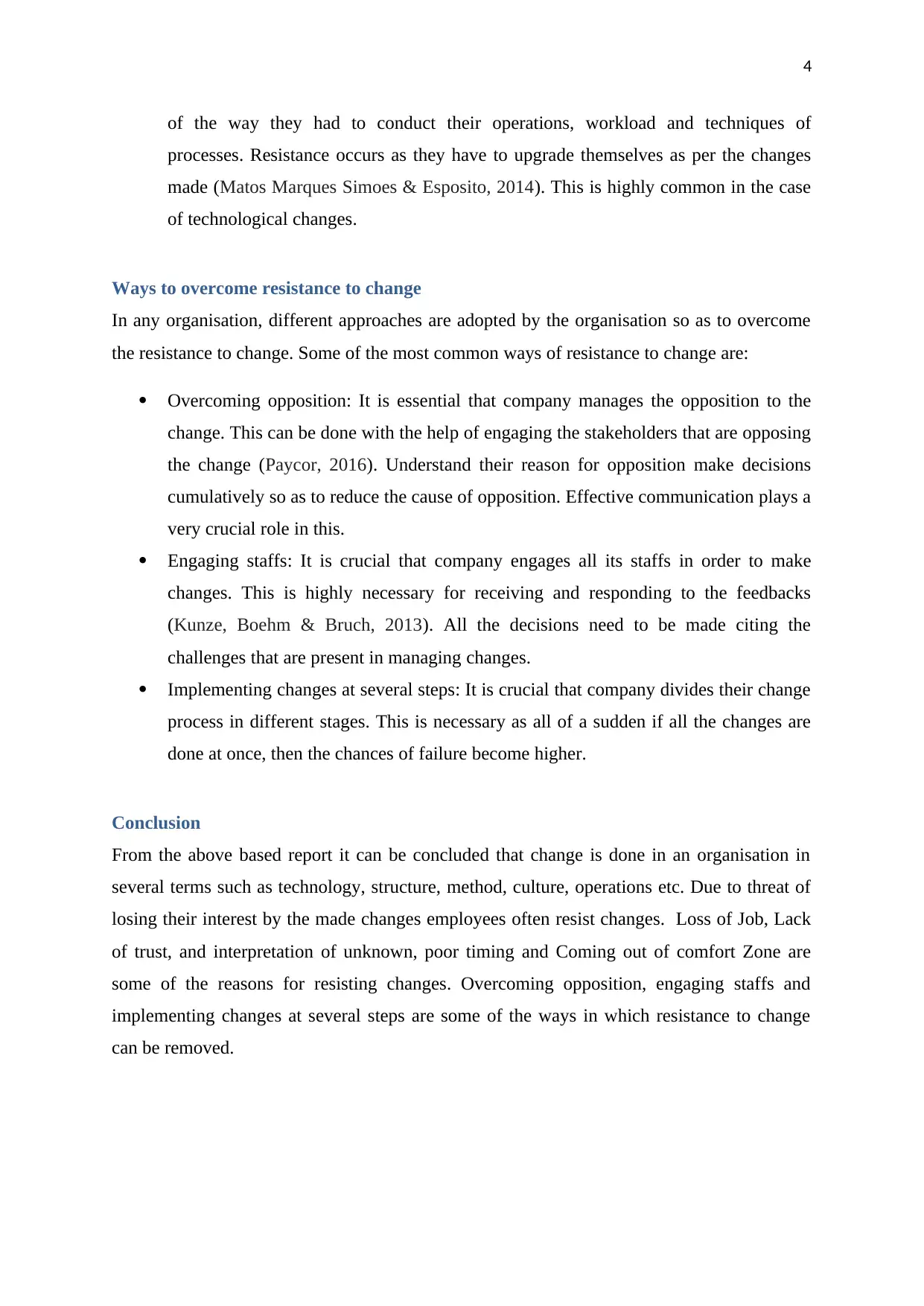
4
of the way they had to conduct their operations, workload and techniques of
processes. Resistance occurs as they have to upgrade themselves as per the changes
made (Matos Marques Simoes & Esposito, 2014). This is highly common in the case
of technological changes.
Ways to overcome resistance to change
In any organisation, different approaches are adopted by the organisation so as to overcome
the resistance to change. Some of the most common ways of resistance to change are:
Overcoming opposition: It is essential that company manages the opposition to the
change. This can be done with the help of engaging the stakeholders that are opposing
the change (Paycor, 2016). Understand their reason for opposition make decisions
cumulatively so as to reduce the cause of opposition. Effective communication plays a
very crucial role in this.
Engaging staffs: It is crucial that company engages all its staffs in order to make
changes. This is highly necessary for receiving and responding to the feedbacks
(Kunze, Boehm & Bruch, 2013). All the decisions need to be made citing the
challenges that are present in managing changes.
Implementing changes at several steps: It is crucial that company divides their change
process in different stages. This is necessary as all of a sudden if all the changes are
done at once, then the chances of failure become higher.
Conclusion
From the above based report it can be concluded that change is done in an organisation in
several terms such as technology, structure, method, culture, operations etc. Due to threat of
losing their interest by the made changes employees often resist changes. Loss of Job, Lack
of trust, and interpretation of unknown, poor timing and Coming out of comfort Zone are
some of the reasons for resisting changes. Overcoming opposition, engaging staffs and
implementing changes at several steps are some of the ways in which resistance to change
can be removed.
of the way they had to conduct their operations, workload and techniques of
processes. Resistance occurs as they have to upgrade themselves as per the changes
made (Matos Marques Simoes & Esposito, 2014). This is highly common in the case
of technological changes.
Ways to overcome resistance to change
In any organisation, different approaches are adopted by the organisation so as to overcome
the resistance to change. Some of the most common ways of resistance to change are:
Overcoming opposition: It is essential that company manages the opposition to the
change. This can be done with the help of engaging the stakeholders that are opposing
the change (Paycor, 2016). Understand their reason for opposition make decisions
cumulatively so as to reduce the cause of opposition. Effective communication plays a
very crucial role in this.
Engaging staffs: It is crucial that company engages all its staffs in order to make
changes. This is highly necessary for receiving and responding to the feedbacks
(Kunze, Boehm & Bruch, 2013). All the decisions need to be made citing the
challenges that are present in managing changes.
Implementing changes at several steps: It is crucial that company divides their change
process in different stages. This is necessary as all of a sudden if all the changes are
done at once, then the chances of failure become higher.
Conclusion
From the above based report it can be concluded that change is done in an organisation in
several terms such as technology, structure, method, culture, operations etc. Due to threat of
losing their interest by the made changes employees often resist changes. Loss of Job, Lack
of trust, and interpretation of unknown, poor timing and Coming out of comfort Zone are
some of the reasons for resisting changes. Overcoming opposition, engaging staffs and
implementing changes at several steps are some of the ways in which resistance to change
can be removed.
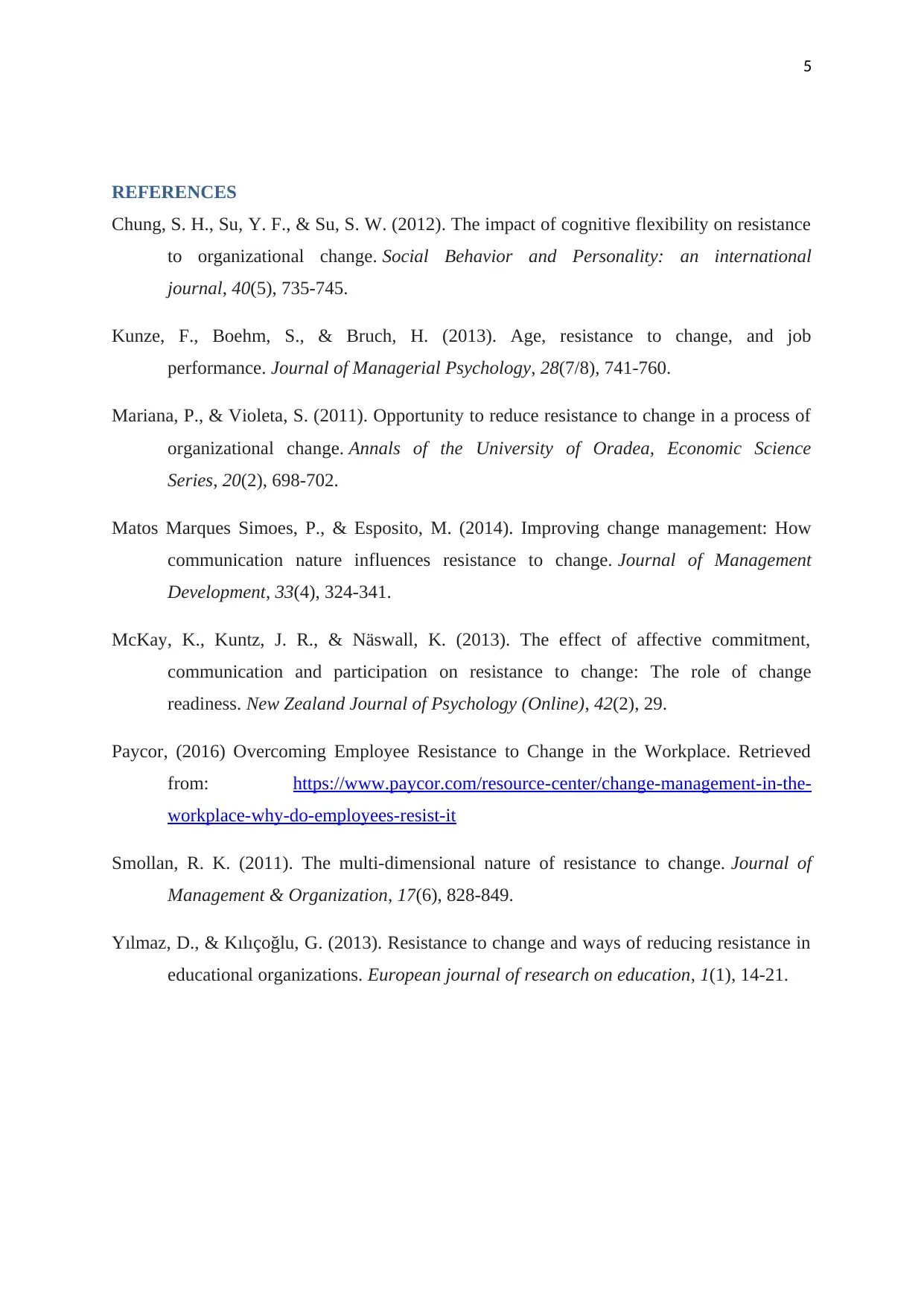
5
REFERENCES
Chung, S. H., Su, Y. F., & Su, S. W. (2012). The impact of cognitive flexibility on resistance
to organizational change. Social Behavior and Personality: an international
journal, 40(5), 735-745.
Kunze, F., Boehm, S., & Bruch, H. (2013). Age, resistance to change, and job
performance. Journal of Managerial Psychology, 28(7/8), 741-760.
Mariana, P., & Violeta, S. (2011). Opportunity to reduce resistance to change in a process of
organizational change. Annals of the University of Oradea, Economic Science
Series, 20(2), 698-702.
Matos Marques Simoes, P., & Esposito, M. (2014). Improving change management: How
communication nature influences resistance to change. Journal of Management
Development, 33(4), 324-341.
McKay, K., Kuntz, J. R., & Näswall, K. (2013). The effect of affective commitment,
communication and participation on resistance to change: The role of change
readiness. New Zealand Journal of Psychology (Online), 42(2), 29.
Paycor, (2016) Overcoming Employee Resistance to Change in the Workplace. Retrieved
from: https://www.paycor.com/resource-center/change-management-in-the-
workplace-why-do-employees-resist-it
Smollan, R. K. (2011). The multi-dimensional nature of resistance to change. Journal of
Management & Organization, 17(6), 828-849.
Yılmaz, D., & Kılıçoğlu, G. (2013). Resistance to change and ways of reducing resistance in
educational organizations. European journal of research on education, 1(1), 14-21.
REFERENCES
Chung, S. H., Su, Y. F., & Su, S. W. (2012). The impact of cognitive flexibility on resistance
to organizational change. Social Behavior and Personality: an international
journal, 40(5), 735-745.
Kunze, F., Boehm, S., & Bruch, H. (2013). Age, resistance to change, and job
performance. Journal of Managerial Psychology, 28(7/8), 741-760.
Mariana, P., & Violeta, S. (2011). Opportunity to reduce resistance to change in a process of
organizational change. Annals of the University of Oradea, Economic Science
Series, 20(2), 698-702.
Matos Marques Simoes, P., & Esposito, M. (2014). Improving change management: How
communication nature influences resistance to change. Journal of Management
Development, 33(4), 324-341.
McKay, K., Kuntz, J. R., & Näswall, K. (2013). The effect of affective commitment,
communication and participation on resistance to change: The role of change
readiness. New Zealand Journal of Psychology (Online), 42(2), 29.
Paycor, (2016) Overcoming Employee Resistance to Change in the Workplace. Retrieved
from: https://www.paycor.com/resource-center/change-management-in-the-
workplace-why-do-employees-resist-it
Smollan, R. K. (2011). The multi-dimensional nature of resistance to change. Journal of
Management & Organization, 17(6), 828-849.
Yılmaz, D., & Kılıçoğlu, G. (2013). Resistance to change and ways of reducing resistance in
educational organizations. European journal of research on education, 1(1), 14-21.
⊘ This is a preview!⊘
Do you want full access?
Subscribe today to unlock all pages.

Trusted by 1+ million students worldwide
1 out of 6
Related Documents
Your All-in-One AI-Powered Toolkit for Academic Success.
+13062052269
info@desklib.com
Available 24*7 on WhatsApp / Email
![[object Object]](/_next/static/media/star-bottom.7253800d.svg)
Unlock your academic potential
Copyright © 2020–2025 A2Z Services. All Rights Reserved. Developed and managed by ZUCOL.




